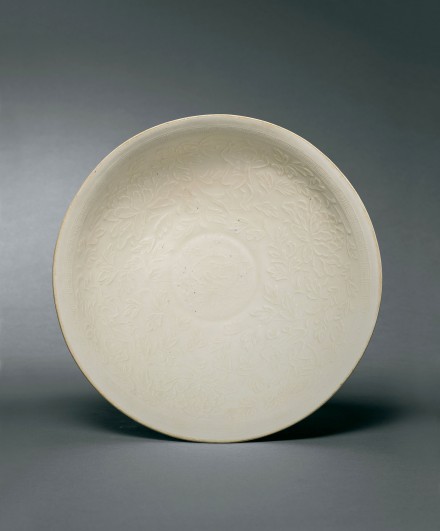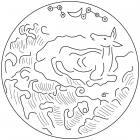J.J. Lally & Co., Oriental Art / New York City, New York
MenuPast Exhibition
Early Chinese Ceramics: An American Private Collection
March 28 - April 16, 2005

33.
A LARGE MOULDED DINGYAO WHITE PORCELAIN ‘BOYS AND PEONIES’ BOWL
Song Dynasty, A.D. 12th Century
decorated on the interior with three young boys dressed in the traditional child’s brief tunics and with simple bracelets around their wrists and ankles, shown frolicking amidst a formal repeating pattern of peony scroll, each boy in a different pose, grasping the scrolling stems and surrounded by scrolling foliage sprouting three large peony blossoms evenly spaced between the boys, all crisply moulded in varied relief and with linear details, enclosing a central medallion moulded with a xiniu, the mythical beast shown with head turned sharply back and gazing at the moon, reclining on a small promontory amidst frothing waves, and with auspicious constellations indicated in the sky on either side of the crescent moon, all enclosed within a keyfret border moulded below the rim, the underside of the bowl entirely plain, covered inside and out with a clear glaze of creamy tone continuing over the small square-cut footring, the mouth rim left unglazed showing the fine white porcelain body.
Diameter 9 5⁄8 inches (24.5 cm)
Only one other example of this rare pattern of moulded Dingyao porcelain bowl appears to have been previously recorded, a smaller bowl of the same design illustrated by Gyllensvärd, Chinese Ceramics in the Carl Kempe Collection, Stockholm, 1964, p. 143, no. 457, with a line drawing on p. 147. The Kempe bowl is illustrated again by Wirgin, Sung Ceramic Designs, Stockholm, 1970, pl. 92b, where the author discusses the motif of boys and floral scrolls as a popular Song motif emblematic of happiness and numerous progeny on pp. 179–184, and provides a summary of scholarly opinion on the theme of the xiniu gazing at the moon, identified with the rhinoceros by some and regarded as a mythical beast related to the unicorn in Western mythology by others, op. cit., pp. 196–198.
Compare the conical Dingyao bowl of smaller size in the British Museum, moulded with a similar design of boys amidst melon vine and lotus, illustrated by Vainker, Chinese Pottery and Porcelain from Prehistory to the Present, New York, 1991, p. 97, no. 70. The same bowl is illustrated again by Wicks and Avril, Children in Chinese Art, Honolulu, 2002, p. 13, fig. 1.10.
宋 定窯印花盤 徑 24.5 厘米
Additional Images (Touch to enlarge)
33.
A LARGE MOULDED DINGYAO WHITE PORCELAIN ‘BOYS AND PEONIES’ BOWL
Song Dynasty, A.D. 12th Century
Diameter 9 5⁄8 inches (24.5 cm)
